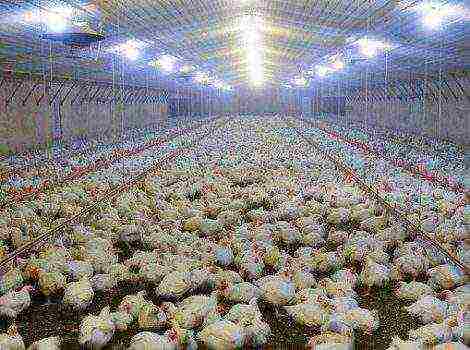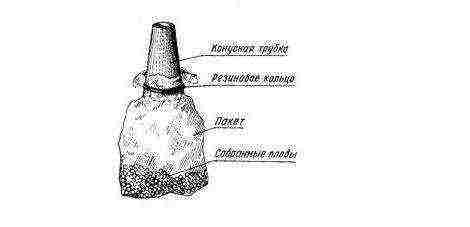Content
- 1 Description of the breed of chickens Leghorn
- 1.1 Appearance, description and photo
- 1.2 Temperament - where is it better to keep in a cage or on a walk
- 1.3 Industrial or hobby poultry
- 1.4 Leghorns in household plots
- 1.5 Characteristics of individuals
- 1.6 Varieties of the breed
- 1.7 Food: chickens, adult chickens, laying hens
- 1.8 Features of the content of Leghorns
- 1.9 Diseases and how to treat them
- 1.10 Advantages and disadvantages
- 1.11 Reviews
Description of the breed of chickens Leghorn
Chickens Leghorn (Leghorn) - a productive breed of egg direction, first bred in Italy. Today, this is the basis for creating variations of egg breeds in the developed poultry industry. There are more than 20 colors of plumage of Leghorn chickens, including white, which are distinguished by their productivity and unpretentiousness. The species lines are constantly being improved and enlarged.
Appearance, description and photo
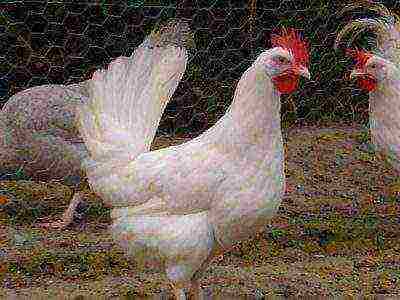 In Russia, mainly Leghorns with white feathers are bred. Considering that the species range of these chickens is developed, there are birds with brown, black, blue, motley, golden plumage. Signs of Leghorn appearance include:
In Russia, mainly Leghorns with white feathers are bred. Considering that the species range of these chickens is developed, there are birds with brown, black, blue, motley, golden plumage. Signs of Leghorn appearance include:
- small size and weight;
- vertical body in the form of a blade;
- elongated body;
- the head is medium in size, the crest of a leaf-like type is erect in roosters and hanging in chickens, white or blue earlobes, red catkins;
- the iris of the eyes in adult chickens is pale yellow, in young representatives of a dark orange color;
- developed rounded chest;
- straight back;
- average leg length in adult chickens;
- the young have yellow skin, and the adults are flesh-colored;
- long wide tail of a rooster at an angle of 40 ° to the body;
- plumage dense.
Temperament - where is it better to keep in a cage or on a walk
Chickens of the Leghorn breed are active, always in motion. It is recommended to keep them in a barn with the possibility of walking. The small size of the birds will save space when choosing a barn. For full development to the place of detention, it is necessary to provide access to fresh air and light. Chickens must live clean. The barn must be equipped with perches, feeders, nests.
 A small area fenced with a net is enough for walking. The height of the fence should not be less than 1.5 m so that the chickens do not fly over the fence. Walking requires feeders and drinkers. In the warm season, chickens are better off being outdoors. They love to dig in the ground in search of worms, pebbles. It is desirable that the grass grows in the fenced area. If there is none, then several times a day chickens should be fed with tops from carrots, beets and other vegetation. In the cold season, the bird is kept in a barn.
A small area fenced with a net is enough for walking. The height of the fence should not be less than 1.5 m so that the chickens do not fly over the fence. Walking requires feeders and drinkers. In the warm season, chickens are better off being outdoors. They love to dig in the ground in search of worms, pebbles. It is desirable that the grass grows in the fenced area. If there is none, then several times a day chickens should be fed with tops from carrots, beets and other vegetation. In the cold season, the bird is kept in a barn.
Important!When there is no way to walk birds due to cold weather, there should be trays with small stones in the barn. Birds peck them up for high-quality grinding of food into the goiter.
Leghorn chickens are allowed in cages. This will save space, the main thing is that the equipped cage is not cramped. Due to the low weight, the chickens do not feel uncomfortable on the net floor. It should be tilted, and egg receptacles are required outside the cage. The distance between the rods of the net should be sufficient for the chicken to stick its head in there and pull it out freely. Cells should be cleaned to avoid disease outbreaks.
Industrial or hobby poultry
Chickens of the Leghorn breed are common in poultry farming of industrial farms in different countries. More than 20 breeding plants throughout Russia are engaged in the transformation and creation of new varieties of this breed, such as dominant, brown Leghorn, Dalmatian.
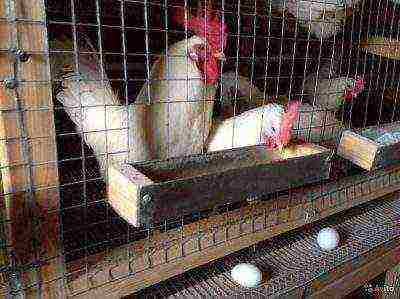 Continuous improvement has allowed hens to lay eggs over 200 days a year. For breeding Leghorns does not require a lot of space and feed... Therefore, today the business of raising chickens for profit is developed.
Continuous improvement has allowed hens to lay eggs over 200 days a year. For breeding Leghorns does not require a lot of space and feed... Therefore, today the business of raising chickens for profit is developed.
In industrial farms, Leghorns are grown in cages, which are located in rows in a barn. Antibiotics and hormones can help cope with illnesses caused by crowding and dirt. However, with them there is a depletion of birds, which entails culling. In an industrial setting, Leghorn chickens are raised for a year and slaughtered to reduce egg production.
Leghorns in household plots
Due to the fact that no strong costs for keeping birds, they are grown even by thrifty poultry lovers, their reviews can be found below. In addition, you can keep Leghorns in chicken coops with other chickens.
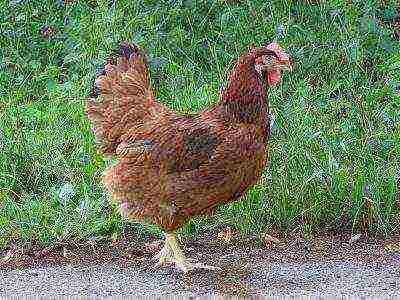 If White Leghorn chickens are grown for commercial purposes, birds with different feather colors are preferred in household plots. These are mainly brown chickens, characterized by large eggs. Productivity is lower, but outwardly they are more interesting than white leghorns, which attracts poultry lovers. Among the species variations of Leghorn, brown ones occupy more than 60%. They are widespread due to the demand for brown eggshells.
If White Leghorn chickens are grown for commercial purposes, birds with different feather colors are preferred in household plots. These are mainly brown chickens, characterized by large eggs. Productivity is lower, but outwardly they are more interesting than white leghorns, which attracts poultry lovers. Among the species variations of Leghorn, brown ones occupy more than 60%. They are widespread due to the demand for brown eggshells.
Brown layers require more attentionthan white. The feeding conditions must be strictly observed; in case of a violation, egg production is restored for a long time. In addition, such chickens are more likely to be infected with infections.
Characteristics of individuals
Leghorn hens weigh between 1.5 and 2 kg, males weigh 2.3-2.7 kg. They begin to lay eggs at 4-5 months, produce 200-250 eggs per year, and sometimes up to 300 pieces or more. The eggs of one-year-old hens weigh within 60 g, the shell is strong white.
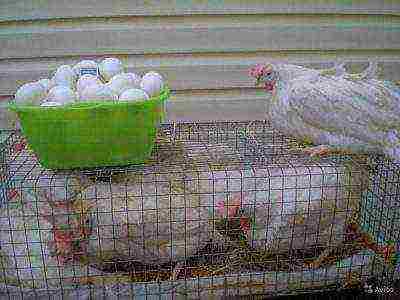 An egg weighing 454 grams was laid by a Blanche Leghorn chicken in 1956. Its shell was double, and there were also two yolks.
An egg weighing 454 grams was laid by a Blanche Leghorn chicken in 1956. Its shell was double, and there were also two yolks.
The fertility rate of eggs is 95%. Chicks are born strong, feathers appear by 2 weeks. For the formation of one egg in a laying hen, 130–150 g of feed is spent. The hatching instinct is absent. Leghorns consume from 110 to 130 g of feed per day... It is impossible to indicate the exact figure, since the indicators differ depending on the species characteristics. To raise chickens up to 18 weeks old, you need to spend 6-7 kg of feed.
Varieties of the breed
White leghorn
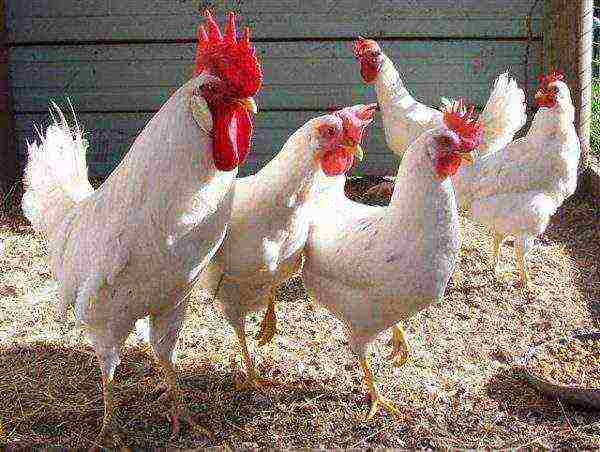
The species differs in that it can live in the southern and northern regions, due to the ability to quickly adapt to conditions. However, White Leghorn chickens are usually raised in poultry houses, and optimal conditions are created there, regardless of weather and climate.
Reference.Russian white chickens are similar to white leghorns. The latter were bred by crossing Leghorns. They are similar in appearance and basic characteristics. But the Russian white wins due to the developed instinct of incubating eggs.
Chickens of the White Leghorn breed are unpretentious in food and conditions of detention. When reared for profit, they are kept in cramped small cages without walking. Due to the constant improvement of the breed, the White Leghorn is able to lay eggs for more than 200 days a year, which brings significant profit to large poultry breeders. Chickens of this species lay a large number of eggs, not only because of their modification, but also because they are given artificial feeding. These dressings destroy the chicken's body, so chickens are not kept for more than a year. Hormones and antibiotics help to survive in crowded and muddy conditions. In business, the main thing is egg production, so specimens trying to hatch eggs are destroyed.
Dwarf leghorns
This dwarf species is referred to as B-33 chickens or White Mini-chickens. Birds look miniature due to the fact that they carry the recessive gene for dwarfism. The weight of the rooster is from 1.4 kg to 1.7 kg, hens weighing less than 1.4 kg. Egg production and survival rates are high, as in all Leghorns. Adult chickens are white, chickens are yellow.
Dwarf Leghorns, despite their activity, do not require a lot of space for keeping, aviary cages are suitable for them.Mini-chickens consume less feed than other breeds of birds with their sizes by 35 - 40 percent. The acclimatization of chickens is going well, they are not afraid of subzero temperatures.
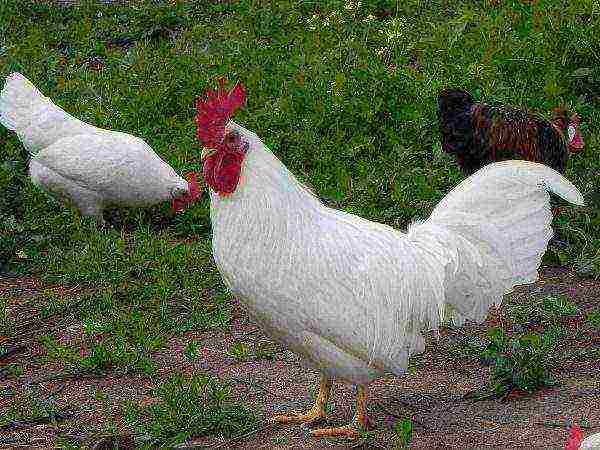 Dwarf leghorns are distinguished by their friendliness towards each other, they get along well with other birds. The fertility of eggs in this species is higher.than other Leghorns and is more than 95%. This is due to the activity of the mini-cockerels. Like all Leghorn chickens, dwarf chickens do not hatch eggs, you cannot do without an incubator. A feature of the B-33 breed during incubation is long-term cooling associated with the large size of the eggs.
Dwarf leghorns are distinguished by their friendliness towards each other, they get along well with other birds. The fertility of eggs in this species is higher.than other Leghorns and is more than 95%. This is due to the activity of the mini-cockerels. Like all Leghorn chickens, dwarf chickens do not hatch eggs, you cannot do without an incubator. A feature of the B-33 breed during incubation is long-term cooling associated with the large size of the eggs.
Dwarf leghorns should be fed with quality and balanced food. The presence of a recessive gene alters metabolic processes, unbalanced feed negatively affects the health of chickens. In particular, excessive protein in food is the cause of curling fingers in chickens 8-10 days of life. Further, they lose limbs and die. In addition, with improper feeding, the egg production of dwarf leghorns drops significantly.
Food: chickens, adult chickens, laying hens
Leghorn food should be fresh. The diet must be balanced so that proteins and minerals reach the chickens in equal parts. However, the menu for the different categories of Leghorns is different:
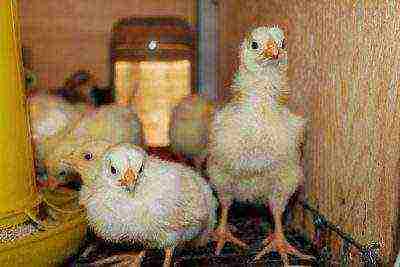 Chicks need more protein in their food. The first day of life, chickens are fed with egg yolk and cottage cheese, on the second day, millet is added to the diet. Some poultry farmers feed small Leghorns from birth with a special “Start for Layers” formula, which is not expensive. At the age of 4 days, the chicks are mixed with green food, such as onions, dandelions, nettles. Crushed eggshells are also beneficial for the growing body. Chalk is added to food on the fifth day of life. 10 days after birth, chicks need to be fed up to 6 times a day. At the age of 21 days, chickens are transferred to an adult diet and food intake is limited to 3. With proper maintenance and nutrition, Leghorns do not die, but grow and gain weight.
Chicks need more protein in their food. The first day of life, chickens are fed with egg yolk and cottage cheese, on the second day, millet is added to the diet. Some poultry farmers feed small Leghorns from birth with a special “Start for Layers” formula, which is not expensive. At the age of 4 days, the chicks are mixed with green food, such as onions, dandelions, nettles. Crushed eggshells are also beneficial for the growing body. Chalk is added to food on the fifth day of life. 10 days after birth, chicks need to be fed up to 6 times a day. At the age of 21 days, chickens are transferred to an adult diet and food intake is limited to 3. With proper maintenance and nutrition, Leghorns do not die, but grow and gain weight.- To feed adults, you need to use the following components:
- corn;
- mineral supplements;
- slaked lime;
- a piece of chalk;
- bone flour.
Leghorns should be fed three times a day. Breakfast and dinner consist of cereals such as barley, wheat. It is worth adding a little salt, chalk and special vitamin supplements to them. For lunch, the Leghorns have mash, to which carrots, potatoes, apples, cabbage, as well as nettles and quinoa are added. You can also add zucchini, beet and carrot tops. Bran and bone meal are integral parts of the chicken diet for full development.
- If chickens need protein, then layers, in addition, need calcium and vitamin supplements for regular egg production. In summer, laying hens consume vitamins from greens, and in winter they need to be fed with boiled vegetables. Calcium in the chicken's body is restored by the consumption of crushed shells, eggshells are less effective. Chickens should have enough food to create eggs, as this is an energy-intensive process. Clean fresh water should be placed near the feed. In winter, it is desirable that it be warm. This is necessary for the formation of the egg.
Features of the content of Leghorns
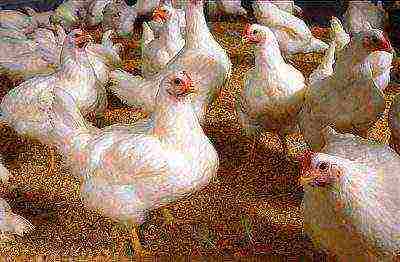 Leghorn is a breed of chickens that is adapted to the cold due to the high density of the feather. However, they lay eggs only in a warm room, where the temperature does not fall below 5 C. Drafts and sudden temperature jumps should not be allowed in the shed. There should be a 50 cm thick warm bedding made of sawdust, straw, hay so that the chickens do not get sick and their egg production does not decrease. In winter, this coating will serve as a source of heat. Avoid crusting at the top.
Leghorn is a breed of chickens that is adapted to the cold due to the high density of the feather. However, they lay eggs only in a warm room, where the temperature does not fall below 5 C. Drafts and sudden temperature jumps should not be allowed in the shed. There should be a 50 cm thick warm bedding made of sawdust, straw, hay so that the chickens do not get sick and their egg production does not decrease. In winter, this coating will serve as a source of heat. Avoid crusting at the top.
The air in the barn should not be dryas it is dangerous for chickens. The lowest value can be 45%. But also excessive humidity should not be allowed.It is necessary to ensure the penetration of air and light to the place where the birds are kept by equipping them with windows and providing ventilation. If Leghorns are not grown in a clean room, then parasites live in the feathers. You can deal with them at home using ash containers. It is more effective to use special preparations in the form of additives in food that get rid of pests. The place where Leghorns are kept must be equipped.
Attention!Full sleep affects the egg production of chickens. The sleeping position should be comfortable so that the perch is firmly gripped by the paws. The poles must be made of the appropriate diameter and rounded.
The perches are placed at a distance of 80 cm from the floor on the side opposite the window. The nests are attached near the perches on the wall.
Diseases and how to treat them
In industrial farms, there is an increased noise level. This provokes the disease inherent in Leghorn chickens - noise hysteria... Layers are particularly susceptible to this disease during laying. The disease is manifested by the fact that the chickens become aggressive towards each other, scream, flap their wings and beat against the walls. Because of this, Leghorns injure themselves and others, lose part of their plumage, and egg production falls. Attacks can occur several times a day. In such a situation, you need to immediately reduce the noise level and create ideal conditions for egg production.
Advantages and disadvantages
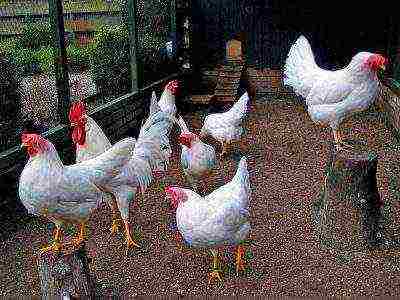 After reviewing the description and characteristics of the Leghorn breed, it is necessary to highlight the pros and cons of this species.
After reviewing the description and characteristics of the Leghorn breed, it is necessary to highlight the pros and cons of this species.
Positive traits:
- Accelerated puberty (4–5 months), high fertility (up to 95%), maximum hatching of chickens (up to 83%).
- High egg production, low feed intake, large eggs.
- The shell is brown. In the store, you can usually find only white eggs, brown ones are rarely on sale, they are quickly sold out.
- Leghorns are grown in our country from the Caucasus to Siberia. Birds easily tolerate cold due to dense plumage and quickly adapt to new conditions, are distinguished by a calm disposition.
Negative qualities:
- The meaty characteristics of the species are poorly developed due to excellence in egg performance
- High egg production only during the year, then it quickly drops
- There is no hatching instinct or maternal instinct. An incubator is required for breeding chickens
- Noise and bright lights can cause the chickens to become hysterical, which is common in this species.
Reviews
Olga, Vologda region Kharovsk
I raise Leghorns in spacious cages, where they feel better. They live with me as families, even in the summer. I did not notice aggressive behavior towards each other. On the walk, chickens and roosters panic, run from side to side, want to crawl somewhere, do not know where to rush. While in a cage, birds lay eggs almost every day. They molted only once. Poultry Forum
Daria Rocheva
I remember that my grandmother used to raise hens of this breed. They did lay eggs almost every day without interruption. Their appearance is beautiful. I'm thinking about getting Leghorns, all that remains is to build a barn in which the birds will feel comfortable. Bird magazine
Pasha838
Everyone says the Leghorns are depleted after a year, I didn't notice that. My birds continue to fly in large numbers, look well-groomed. As for food, crushed shells, millet, proteins are always available. I usually give the chickens kitchen waste: from dumplings to cottage cheese. To breed Leghorns at home, you need an incubator or brood hen that can hatch Leghorn eggs. Poultry storage
Breeding Leghorn chickens on a personal backyard brings only positive aspects to the poultry farmer. Growing for industrial purposes also brings good profits. Unpretentious maintenance will allow you to get delicious eggs at minimal cost. The prevalence of the breed allows you to acquire hatching eggs and young chickens at any time of the year without any problems.
